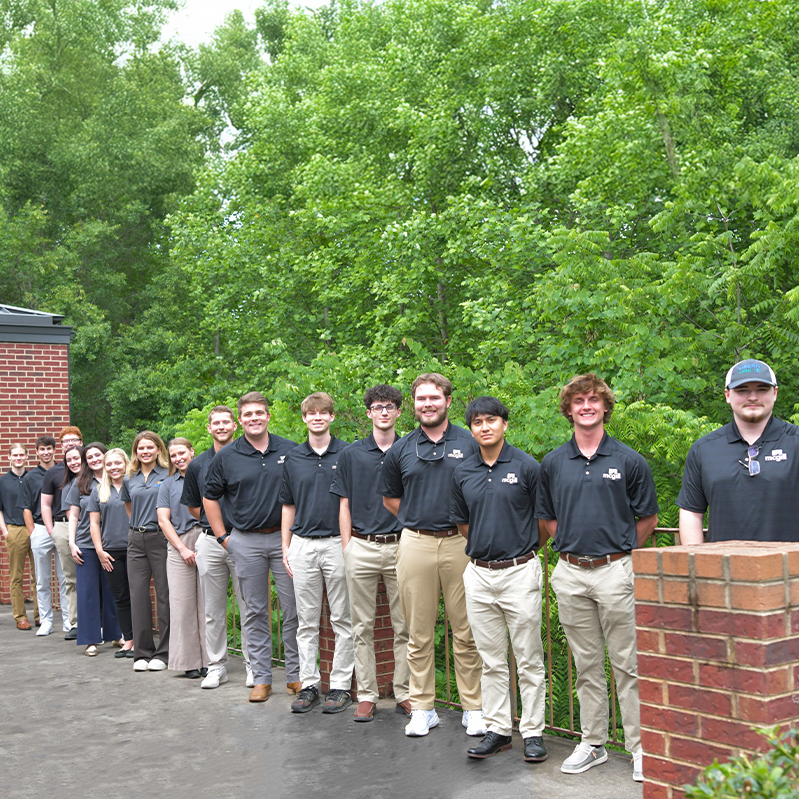
Professional Engineers Day 2025
Thoughts and Advice on the Road to Licensure
The process to become a licensed professional engineer (PE) is slightly different for each state, but one needs to complete several common steps, including:
- earning an accredited engineering degree
- passing the Fundamentals of Engineering (FE) exam
- gaining four years of acceptable engineering experience
- passing the Principles and Practice of Engineering (PE) exam
Becoming a PE is not easy, but it is a step many aspiring engineers decide to take. Though not required to continue along the engineering career path, acquiring a PE license allows one to advance their career, increase earning potential, and build credibility in the industry.

We talked to two PEs at McGill (Nick Huffman, Mechanical / Electrical / Plumbing Practice Area Leader, and Joel Whitford, Senior Project Manager on our water / wastewater team) about the process and their advice to those interested in becoming a PE. Their thoughts are synthesized below.

Q&A
There are several steps one needs to take before becoming a PE (including those listed above), but what is not included on that list that is something to know about becoming a PE?
Huffman and Whitford recommend, when working under a licensed PE, maintaining a clear record of the projects on which you have worked, such as the details of the project, your role in the project, etc. Keep this detailed information for at least a few projects, as this is needed to complete the application process to apply for your PE. Seeking to gain diverse project experience during the early years will help as well.
What is your advice for someone who wants to get their PE? What do you wish someone would have told you about it?
Earning your PE license is a major career milestone. It leads to opportunities for increased roles on projects.
Huffman suggests taking your FE exam while in college, if possible. Looking back, he would have explored the whole PE process in college more. Huffman said he was encouraged to take the FE exam while in school, but his workload did not allow it at the time, so he did not take it until two and a half years later after graduation, which made it much harder to remember the FE exam material that was not focused on his discipline.
Whitford encourages people to perform quality engineering work while actively learning from others’ experiences and past lessons. Earning your PE enhances your professional credibility, but it also brings the obligation to produce quality work.
What has been your experience in mentoring people through the PE process?
Most often, confidence is often the biggest barrier to the PE exam, not a lack of knowledge. Many capable engineering associates (EAs) delay the PE exam because they fear the test or the time it takes to prepare.
Huffman and Whitford ensure their employees have a good foundation of work that is relevant to some of the questions they might see on the PE exam.
Understanding the specific codes related to your discipline, such as the National Electrical Code (NEC) for electrical engineering, is important, since you apply those codes nearly every day in design. Explaining concepts to others is one of the best ways to sharpen your own skills and have a deeper understanding of the material. Keeping in mind that everyone learns differently, you must engage each employee to find out their learning style.
Describe an example mentoring an EA who was on their way to becoming a PE.
Huffman:
There are larger, more complex engineering projects and there are smaller, more straightforward ones. Before introducing EAs to more difficult projects, I start them out on smaller projects first. When out in the field gathering data during the first site visit, I explain what we are trying to accomplish and the information we are after. I allow them to take pictures and sketch diagrams of the system. The point of learning comes when they are back in the office and start to build the model in the software program we use. This is where we find out if all the information they needed to collect was done correctly and if any information is missing (i.e., did a picture turn out blurry and we cannot read the equipment label correctly to input the data into the model?). At this point, the EA realizes how crucial checking photos and writing down pertinent information about the system is for project efficiency. At this point, the EA may need to revisit the site for any missing or unclear information. This teaches the EA to take their time and review the details of the project when conducting a site visit, as the devil can be in the details of a project to ensure project success.
Whitford:
I worked with an EA who was technically strong but needed more experience preparing engineering reports. This is a skill that is increasingly important as engineers move along in their careers. We began by reviewing a recent report, and I provided feedback on report structure and clarity, helping to make the technical content more understandable to non-engineers. Over the next week, we collaborated on editing a few sections of the report. The EA revised sections of the report based on my feedback rather than rewriting it myself, to help build confidence and ownership. The EA quickly improved in writing with clarity and conciseness, resulting in boosted confidence and more effective communications – a key step in professional development.
Celebrating Our Engineers
We are proud of our employees who work hard to become registered PEs and we celebrate them every day, but especially on national PE Day. Read more about the day.
Work With Our Team
McGill provides a supportive, inclusive environment where your growth is prioritized. We support career development in multiple capacities (not only in pursuing a PE). If you are interested in working with our team, learn more about careers at McGill and view current job openings.


